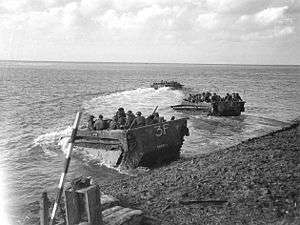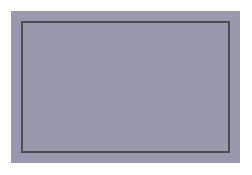7th Canadian Infantry Brigade
| 7th Canadian Infantry Brigade | |
|---|---|
|
3rd Canadian Infantry Division formation patch | |
| Active | 1940–1945 |
| Country |
|
| Branch | Canadian Army |
| Type | Infantry |
| Size | Brigade |
| Part of | 3rd Canadian Infantry Division |
| Nickname(s) | "Water Rats" |
| Engagements | |
The 7th Canadian Infantry Brigade was an infantry brigade of the Canadian Army that fought during World War II. The brigade, along with the 8th Canadian Infantry Brigade and the 9th Canadian Infantry Brigade, formed the 3rd Canadian Infantry Division. The division arrived in the United Kingdom in 1940 and spent three years in garrison duties and training in preparation for the assault landings on Juno Beach in Normandy on 6 June 1944.
Formation



- Brigadier Harry Wickwire Foster
- 1st Battalion, Royal Winnipeg Rifles, Lieutenant-Colonel J.M. Meldram
- 1st Battalion, Regina Rifle Regiment, Lieutenant-Colonel F.M. Matheson
- 1st Battalion, Canadian Scottish Regiment, Lieutenant-Colonel F.N. Cabeldu
- 7th Infantry Brigade Ground Defence Platoon (Lorne Scots)
Juno Beach, D-Day
Juno Beach was five miles wide and stretched on either side of Courseulles-sur-Mer.
The 3rd Canadian Infantry Division was the assault division, along with the 2nd Canadian Armoured Brigade under command to provide armoured support for the infantry assault brigades.
The 7th Canadian Infantry Brigade had been selected to take part in the initial assault. They would land on the left hand side of the beach, supported by the 6th Armoured Regiment (1st Hussars).
During the assault the Regina Rifles would land at Courseulles which had the code name Nan Green beach, the Royal Winnipeg Rifles would land on the western edge of Courseulles, which had the code names Mike Red beach and Mike Green beach.
So far, not a shot has been fired from the defenders on the beach. Will it be a push-over? We soon have the answer in the form of machine-gun fire and shells from pillboxes which are apparently still open for business despite the terrific pounding they have taken. The LCA's of the leading companies and the tanks of the 1st Hussars are working into the beaches now. H-hour has arrived. For the purposes of the assault, Courseulles had been divided into blocks numbered one to twelve. Each was to be cleared by a designated company. Careful study of enlarged air photos showing the sites of enemy strong points had made the ground itself easily recognizable. Every foot of the town was known before it was entered.— Major Gordon Baird, The Regina Rifle Regiment 1939–1945
In the first hour of the assault on Juno Beach, the Canadian forces suffered approximately 50% casualty rates, comparable to those suffered by the Americans at Omaha Beach. Once the Canadians cleared the seawall (about an hour after leaving the landing craft transports) they started to advance quickly inland and had a much easier time subduing the German defences than the Americans at Omaha had. By noon, the entire 3rd Canadian Division was ashore and leading elements had pushed several kilometres inland to seize bridges over the Seulles River. By 6 pm they had captured the town of Saint-Aubin-sur-Mer.[1] By the end of D-Day the elements of the 3rd Canadian Infantry Division had penetrated farther into France than any other Allied force, though counter-attacks by two German armoured divisions would stop any further movement for several weeks.
None of the assault divisions, including 3rd Canadian Division, had managed to secure their D-Day objectives, which lay inland, although the Canadians came closer than any other Allied formation.[2]
By the end of the next day, the Canadian forces had linked up with the British forces that had landed at Sword Beach.
Battle of Normandy
On 8 June, SS-Panzergrenadier-Regiment 26 under command of SS-Obersturmbannfuhrer Wilhelm Mohnke arrived on the battlefield. Their orders were to drive over the Canadians and force a deep wedge between them and the British division to the west. The attack, launched at 03:30 but had little initial success. The various companies in the attacking 12th SS Panzer Division failed to co-ordinate their moves towards the Canadians, and, despite heavy casualties during repeated attempts by the infantry, Canadian artillery and supporting heavy machine guns of the Cameron Highlanders of Ottawa took a heavy toll on each attacking company of SS troops. The Regina Rifle Regiment held their ground and the I Battalion fell back.
On the Canadian right the II Battalion attacked the Royal Winnipeg Rifles defending the village of Putot-en-Bessin. The battalion managed to break into the village and surround several companies, effectively pushing the Winnipegs out of the village, inflicting 256 casualties – of which 175 were taken prisoner. A counter-attack launched at 20:30 by the Canadian Scottish Regiment, however, regained Putot-en-Bessin, and the II Battalion withdrew and dug in south of the village.
Following the battle SS-Aufklärungs-Abteilung 12 deployed to the west of Mohnke's regiment and, by the evening of 8 June the division, while having failed in its assignment to drive the Canadians into the sea, had effectively halted the units of the 3rd Canadian Infantry Division, in the Allied advance on Caen.

Spending much of the next four weeks in static positions, the division participated in the battles to capture Caen in early July, known as Operation Charnwood, followed by Operation Totalize and Operation Tractable and the battles around Verrières Ridge, during the rest of the month.
The brigade then took part in the pursuit across France, and clearing the Channel ports, most notably Boulogne, Calais and Cape Gris Nez.

Battle of the Scheldt
Operation Switchback
The second main operation of the Battle of the Scheldt opened with fierce fighting to reduce the Breskens pocket. Here, the 3rd Canadian Infantry Division encountered tenacious German resistance as they fought to cross the Leopold Canal.[3]
It was decided that the best place for an assault would be immediately east of where the two canals divided: a narrow strip of dry ground only a few hundred metres wide at its base beyond the Leopold Canal (described as a long triangle with its base on the Maldegem-Aardenburg road and its apex near the village of Moershoofd some five kilometres east).
A two-pronged assault commenced. 7th Canadian Infantry Brigade made the initial assault across the Leopold Canal, while the 9th Canadian Infantry Brigade mounted an amphibious attack from the northern or coastal side of the pocket. The assault began on October 6, supported by extensive artillery and Canadian-built Wasp Universal Carriers, which were equipped with flamethrowers. The Wasps launched their barrage of flame across the Leopold Canal, allowing the 7th Brigade troops to scramble up over the steep banks and launch their assault boats. Two precarious, separate footholds were established, but the enemy recovered from the shock of the flamethrowers and counter-attacked, though they were unable to move the Canadians from their extremely vulnerable bridgeheads. By October 9, the gap between the bridgeheads was closed, and by early morning on October 12, a position had been gained across the Aardenburg road.
The 3rd Division fought additional actions to clear German troops from the towns of Breskens, Oostburg, Zuidzande and Cadzand, as well as the coastal fortress Fort Frederik Hendrik. Operation Switchback ended on November 3 when the First Canadian Army liberated the Belgian towns of Knokke and Zeebrugge, officially closing the Breskens Pocket and eliminating all German forces south of the Scheldt.
After spending three months in static positions in the Nijmegen Salient, the division engaged in fierce combat once more in February. Fighting once again through flooded terrain, the brigade helped clear the last German positions west of the Rhine. The brigade fought on into Germany and were ordered to suspend operations on 4 May 1945.
See also
References
Further reading
- Official History of the Canadian Army in the Second World War Volume III, The Victory Campaign: The Operations in North-West Europe, Colonel C.P. Stacey. Queen's Printer, Ottawa. 1966.
- Juno: Canadians at D-Day June 6, 1944, Ted Barris, National Library of Canada Cataloguing in Publication, 2004.
- Maple Leaf Route: Caen, Terry Copp and Robert Vogel, Maple Leaf Route, 1994.
- Six Armies in Normandy, John Keegan, British Library Cataloguing in Publication Data, 1982.
- Bloody Victory: Canadians and the D-Day Campaign, J.L. Granatstein and Desmond Morton, Toronto: Lestor, 1994.
- Battle Diary: From D-Day and Normandy to the Zuider Zee and VE, Charles Cromwell Martin, Dundurn Press Toronto & Oxford, 1994.
- Ready for the Fray: The History of the Canadian Scottish Regiment, R.H. Roy, Evergreen Press, Vancouver, 1958.
- Vanguard: The Fort Garry Horse in The Second World War, The Fort Garry Horse Museum and Archives, Hignell Printing Ltd, 1995.
- The History of the 1st Battalion Cameron Highlanders of Ottawa (MG), Lieutenant Colonel Richard M. Ross, O.B.E., Runge Press Limited, Ottawa 1946.
- An Historical Account of the 7th Canadian Reconnaissance Regiment, Capt. Walter G. Pavey, Copyright 1948 by 7th Canadian Reconnaissance Regiment, Montreal, 1995.
- The Royal Canadian Armoured Corps, John Marteinson & Micahael McNorgan, Royal Canadian Armoured Corps Assoc, 2000.
- The History of the Corp of Royal Canadian Engineers, A.J. Kerry & W.A. McDill, Military Engineers Association of Canada, 1966.
